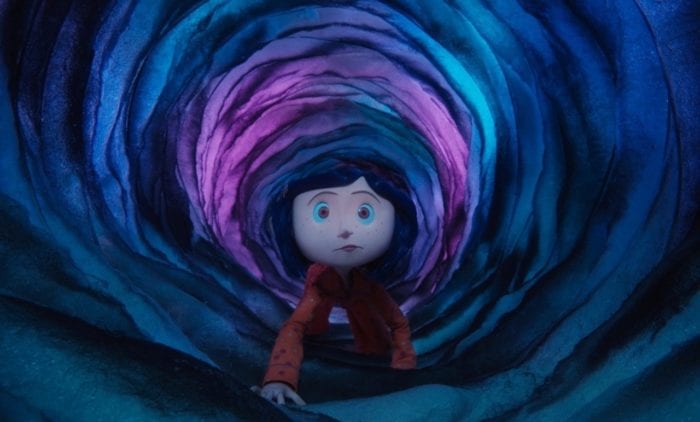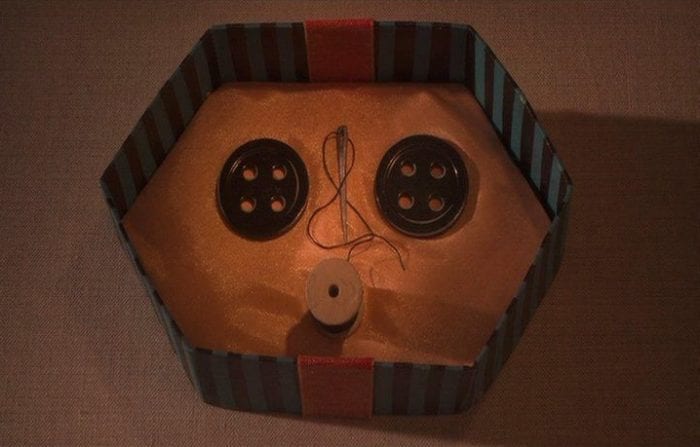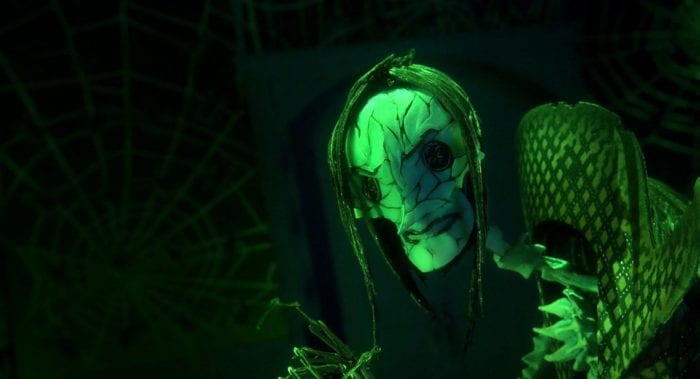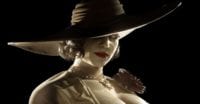Described as a “horror film for children,” the film adaptation of Neil Gaiman’s 2002 novella, Coraline, still lives on in the nightmares of fans, children, and adults alike. After moving house, the eponymous, blue-haired heroine soon discovers a tunnel leading to an idyllic version of her house and family—but all is not as blissful as it seems, and the halcyon realm progressively becomes more terrifying throughout. Famously, the only reason the story was published as children’s fiction as opposed to adult fiction was because Gaiman’s co-worker’s daughter claimed she wasn’t scared by it, lying to her mother so she could read on and find out what happened next. According to Gaiman himself, readers tend to be split in their reaction, depending on age:
Adults completely love it and they tell me it gave them nightmares. They found it really scary and disturbing, and they’re not sure it’s a good book for kids, but they loved it. Reading audience number two are kids who read it as an adventure and they love it. They don’t get nightmares, and they don’t find it scary.
This is obviously a generalization that doesn’t apply to all children, but the distinction is a worthy observation. For children, the intrigue comes from the adventure Coraline provides for the child protagonist whom they relate to, but adults may find fear in how the Other Mother is a concerning reflection of extreme and unhealthy parenting. Although the medium of film has an effect in removing the input of visual imagination, presenting a truly nightmare-inducing, insectoid villain toward the end, it could be argued that the subtext of psychology creates more horror. Elements of the uncanny, coming to terms with the daunting, unchartered territory of childhood and growing up, and toxic parenthood all generate fear throughout the narrative of Coraline.

Freud referred to the concept of the uncanny as ‘the unheimlich’ (the un-homely), which Coraline takes literally by introducing a home that isn’t quite a home. The effect of the uncanny is said to arise “when the boundary between fantasy and reality is blurred,” and the tunnel between Coraline’s World and the Other World acts as this boundary. We instantly feel as though something is off when Coraline arrives in the Other World, simply because of its existence. Later, when we find out that the Other Mother has malicious motives, our worst fears are confirmed, and further uncanniness occurs in the juxtaposition of the villain’s sickly sweet façade and co-existing deeper malevolence.
Additionally, Freud lists the three main repressed childhood complexes in regards to the uncanny: wish-fulfillment, castration, and womb fantasy. All three manifest as types of horror throughout Coraline. Based on the pleasure principle, wish-fulfilment is “rooted in the child’s mind,” and involves seeking immediate desire satisfaction. For Coraline, this is demonstrated by the Other World’s idealism; on arrival, the Other Mother and Father present her with a delicious meal, filled with everything she loves. They give her presents, toys, and treats, as well as smothering her with outspoken love and affection. It’s natural for any child to want this, but the Other Parents’ selfish motive taints their actions and infers a ‘be careful what you wish for’ message.
Castration in this context refers to the loss of eyes, as the visual creepiness of the Other Family stems from their button eyes, and the cost of permanent wish-fulfillment for Coraline is having her eyes also replaced with buttons. Drawing attention to sight represents how Coraline’s perception changes throughout; her expectations of her real parents are lowered at the end. Other castration fears include Wybie’s mouth being permanently shut, and later fixed into a smile (loss of speech and expression), and the Other Mother’s needle hand managing to cross over into Coraline’s World (loss of a limb). These representations of castration are fearful in terms of body horror as well as what they psychologically symbolize. Womb fantasy refers to a desire to return to the womb, which links to a sort of emotional dependence. Here, this is expressed via the Other Mother more than Coraline, shown through her unhealthy obsession with capturing children—the ghost children are locked in a cupboard, and she even attempts to trap Coraline in a web, both of which function as metaphors for the womb. Coraline having to overcome each of these uncanny repressed childhood complexes in the form of various horrors represents her growth and maturation throughout the narrative.

Alongside the disorientation and trickiness of growing up, Coraline’s journey is one of discovering and differentiating her personal identity from that of her parents (or adults in general). One of the most significant differences between the novel and film is Coraline’s personality; in the book, she is more introverted and quietly intelligent, whereas film Coraline is more actively angry and expressive. Despite this, her journey is essentially the same.
Having just moved house, and with little regard from her workaholic parents, Coraline is always “exploring” on her own. Like all children, she has an innate curiosity that drives her to wander and investigate, but it’s also reflective of a journey toward finding herself. Rebuffing her pleas for attention at the start of the film, Coraline’s father encourages her to “explore” the house (in his words), suggesting she count all the windows and list everything that’s blue. These are very ordinary objects that lack any emotional or educational stimulation, and the task is clearly restrictive for Coraline—she describes everything as “boring” as she completes the task. From the beginning, we see she is outgrowing this small world, yet tied to a dependence on her parents to provide something they aren’t available for.
Another obvious tool to demonstrate how Coraline is othered and misunderstood by the people (especially adults) in her life is the constant mispronunciation of her name. Names are always significant character indicators, and in the book, the cat refers to how humans “have names… because you don’t know who you are,” further implying that a key aspect of Caroline’s journey is identity-centric. An inversion of “Caroline,” her name is already off-kilter and sets her apart as different (as does her distinctive blue hair). Wybie immediately mispronounces it as “Caroline” upon meeting her, claiming that “an ordinary name like Caroline can lead people to have ordinary expectations about a person,” so we can infer that Coraline is therefore perceived as extra-ordinary, or abnormal.
When Coraline feels rejected or misconstrued in any way, she reacts with anger, such as when Wybie calls her “crazy” when she tells him about the Other Mother after escaping. She throws her shoes at him, exclaiming “you’re not listening to me!” The Other Mother uses this mistreatment to her advantage, claiming “you’ll go home and be bored and neglected as always.” In the book, this is extended further into “[n]o one will listen to you, really listen to you. You’re too clever and too quiet for them to understand. They don’t even get your name right.” From this, we know that Coraline’s insecurities stem from being misunderstood, perhaps further indicating a loose grasp on her own identity.
The Other Mother also designs a doll that looks exactly like Coraline to lure her in, as she does with every child she targets. It’s significant that Coraline carries around a silent, immobile version of herself (she describes it as “little me”), unable to grow or develop. The Other Mother wants to trap her in this perpetual stasis, therefore, this doll represents a regressive state that Coraline is trying to break free from. The doll also symbolizes her desperate reliance on her real parents; later in the film, when Coraline’s real parents go missing, she creates similar replicas of them out of pillows to sleep next to. This particular moment tugs on my heartstrings, as we see Coraline’s vulnerability and craving for reassurance—she’s just a kid, after all. Right after this, she finds an extremely creepy conjoined doll of her parents, made by the Other Mother. The dolls she makes are a representation of control and twist Coraline’s innocent need for a nurturing parental presence into something uncanny and disturbing.

Manipulation and control are at the core of the Other Mother’s villainy. Her attitude and actions function as a really quite astute and horrifying portrayal of toxic parenthood. The Other World is designed to meet Coraline’s needs, and the Other Parents provide instant gratification: a huge feast when she’s complained about her real parents’ meals being unsatisfying, correctly pronouncing her name when others rarely do (in the form of a song about her, no less), planting a whole garden in the shape of her face, and showering her with endless love and affection. This overcompensation for the Other Mother’s villainy serves to draw Coraline in, so she feels guilty for not reciprocating.
As the ghost children say, “she lured us away with treasures and treats and games to play…so we let her sew the buttons”—the Other Mother presents Coraline and the other children with everything good first, so it’s more difficult for them to back out. When asking her to sew the buttons in her eyes, the Other Mother tells Coraline “it’s your decision.” Framing the choice as hers gives Coraline the illusion of control, and also allows for placing the blame on her if things go wrong. The Other Mother further says “remember, we only want the best for you,” still under the guise of being a caring parent, when actually we know her motivations are selfish. As expected, the Other Mother locks Coraline away in a cupboard when she refuses her, telling her “you may come out when you’ve learned to be a loving daughter,” twisting the narrative to frame Coraline as selfish.
In the process of manipulating Coraline, the Other Mother and Father also infantilize her, exposing their toxic tactics. Coraline’s bedroom in the Other World, which her Other Parents proudly present to her, is full of toys that speak and jump around the room. An overt representation of childhood, the toys reveal how the Other Parents perceive Coraline as a child before an individual. Ironically, Coraline complains when her real father calls her a “dizzy dreamer” and tweaks her nose playfully, saying “Dad, I’m not five anymore!” The Other Father often refers to her as “kiddo,” which she doesn’t recognize as condescending.
Coraline fails to see that the Other Parents are actually infantilizing her, whereas her real parents are forcing independence on her by leaving her alone most of the time. Furthermore, the ghost children represent a regressed, frozen state of childhood that Coraline is attempting to escape from. To “lose the game” would be to accept “perpetual childhood,” which is what the Other Mother is attempting to enforce via infantilization. This aspect of toxic parenthood, the insistence that their child be treated as such, and remain emotionally dependent on them, has a detrimental effect on the child, preventing them from maturing.
An attempt to create emotional dependence is repeated with the Other Mother throughout as a prime manipulation tactic. Comparing the flaws of Coraline’s World to the idealism of the Other World, the Other Mother uses the words “bored” and “neglected” to describe her position in her real life, saying “stay here with us.” This seduction is intended to prevent Coraline from leaving by essentially proving to her that any validation and self-esteem comes from the Other World. Even when Coraline does attempt to walk away, the Other World reforms in front of her; as she says to the cat, “How can you walk away from something but still come back to it?” This sums up toxic parenthood because the child is incapable of being truly free from the parent due to an enforced emotional dependence.
Referring to her taxidermy dogs, Miss Spink tells Coraline she “couldn’t bear to part with them, so we had them stuffed.” This kind of unhealthy attachment applies directly to the Other Mother’s approach to Coraline and the other children—if she can’t keep them, she’ll trap them forever. The ghost children further tell Coraline, “even if you win, she’ll never let you go;” there is no “winning” with manipulative or toxic people. Even after the Other Mother has transformed into her terrifying, grotesque spider form, attempting to trap Coraline in a web (an apt visual representation), she calls Coraline a “selfish brat,” still intent on twisting the narrative to frame herself as the victim and Coraline as the bad guy. Classic manipulator’s move. The Other Mother begs “don’t leave me, I’ll die without you” as a final attempt to appeal to her guilt, but at this point, she has irreversibly exposed her monstrous nature.

Throughout the story, Coraline comes to terms with reevaluating her intense dependence on her real parents by escaping the toxic clutches of the Other Mother. While undertaking the quest to retrieve the ghost children’s eyes and free them, some vines controlled by the Other Mother wrap around her in the garden, and her chopping them with secateurs represents her emotionally cutting ties of dependence with parental figures. The whole fabric of reality in the Other World dissolves and caves in on her, representing how her perception needs to be destroyed in order for her to develop.
No doubt about it, her parents are negligent and neglectful, and their treatment of their daughter isn’t okay. Sadly, they have no memory or awareness of the events of the story—either their memories were erased by the Other Mother, or it’s implied that their supposed kidnapping was another of the Other Mother’s illusions to make Coraline come back to her. As a result, the parents undergo no personal development, but Coraline does, which makes all the difference. An integral part of growing up is lowering the pedestal on which we place our parents, and detaching our identity from them, which is what Coraline learns to do.
In the end, the residents of Pink Palace Apartments have a garden party, planting flowers together. Coraline’s parents are far from perfect, and she still gets called “Caroline,” but she’s learned to be content with it. As she says to her mother at the start, “I want stuff growing when my friends come to visit. Isn’t that why we moved here?” Coraline has already begun growing, and maybe now everyone else can grow with her, too.


